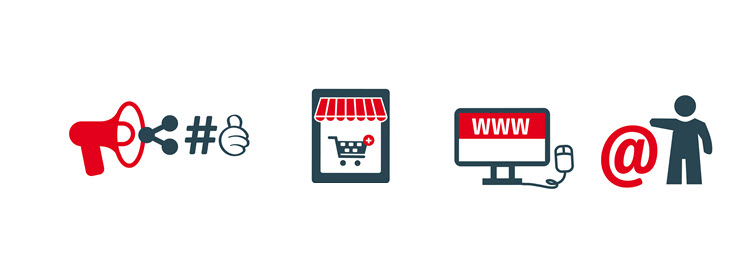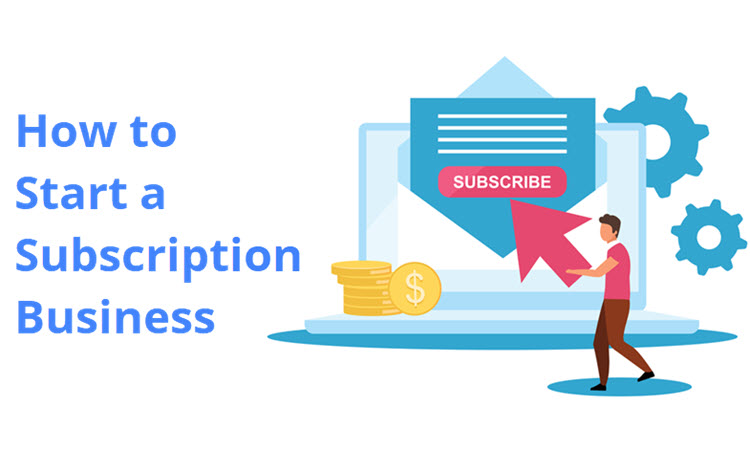Contemporary digital services have brought new subscription-based models to a wide range of industries.
Membership sites, streaming services, fitness services, and food delivery services are only some examples of niches where subscriptions are commonly used.
In this article, we’ll explain how to start a subscription business successfully.
What Is a Subscription-Based Business Model?

A subscription-based business model is a model in which a company collects a certain amount of money monthly or annually from a consumer to provide them with pre-determined products or services.
Netflix, Amazon Prime Video, Comcast, AT&T, and many other companies use this recurring-revenue model to ensure a steady source of income.
Consumers that opt for this business model know what services they can expect for a specific amount of money. It ensures that they receive the desired product or service when they need it.
Subscription Businesses Market Analysis
- 78% of international consumers use subscription services.
- The global market value of the subscription economy is expected to reach $1.5 trillion by 2025.
- 53% of software revenue is generated from a subscription business model.
- The market demands that new and legacy software vendors offer Software-as-a-Service options. 80% of legacy software vendors have adopted a subscription-based business model.
- The size of the global car subscription market is expected to reach $21,159 million in 2030.
- 85% of US households use at least one video subscription service, while 60% use at least one paid music streaming service.
Starting a Subscription Business Guide
If you want to start a subscription business, you need to know what steps to take to do it properly. We’ll cover those stages in the following paragraphs.
Choose a Subscription Business Model
There are several standard subscription models that most companies use:
Replenishment Subscription Model
The replenishment subscription model allows customers to place orders that renew on a weekly, monthly, quarterly, or annual basis. Orders can typically be modified or paused at any moment with no additional cost.
This model is typically used to sell products that are considered personal or household essentials. Once customers make an initial order, they get refills/replenishments delivered regularly. The success of this model lies in its convenience, as it eliminates the need for regular trips to a physical store to restock.
Pros:
- Higher conversion rates. Businesses that adopt the replenishment subscription model experience an average conversion rate of 65%. The next best-performing model is curation, at 52%.
- Higher retention rates. 45% of replenishment subscriptions last a year or longer.
Cons:
- Thin margins. To become and remain competitive in the market, replenishment subscription merchants must maintain competitive prices and offer frequent discounts.
- Best for big merchants. To sustain competitive prices and be able to offer discounts, merchants must keep production costs low while selling as many products as possible.
Curation Subscription Model
The curation subscription model, also known as the subscription box model, is a popular model that embraces ecommerce personalization by periodically delivering a curated selection of products.
Typically, products are curated:
- By randomization.
- Based on information provided by the user (for example, a quiz).
- By the merchant or a curator.
Pros:
- Opportunity for high profit. Statista analyzed US consumers monthly subscription box expenditure and extracted the following average values based on product category – $74 for food, $64 for fashion, $46 for technology, $34 for personal care and beauty, and $28 for pet care.
- Product promotion. One of the common reasons why customers subscribe is to try out new products and find new personal “essentials.” This makes curated boxes a fantastic opportunity to introduce new products to a target audience.
Cons:
- High churn. Subscription box products are typically non-essential luxury items, and customers treat them as such, meaning these subscriptions are typically shorter-lived than other models. According to Whistl, an average subscription box subscription lasts 9 months. In addition, subscription box brands usually drive the most interest when they enter the market with something fresh and unique, but once that novelty is lost, customers lose interest.
- High costs. Basic operating costs (production, packaging, shipping) and marketing are expensive. Subscription box businesses must invest more in customer acquisition than companies adopting other subscription models.
Access Subscription Model
The access subscription model refers to two types of subscriptions:
- Content access – Customers subscribe to gain access to digital media, such as music, movies, games, podcasts, etc.
- Membership – Customers subscribe to obtain member-only perks, such as lower prices, order priority, faster or free shipping, etc.
Pros:
- Membership subscriptions invoke a sense of luxury and promote customer loyalty. Customers loyal to a brand want to be the first to know about new products and promotional activities. A membership subscription grants these wishes. In addition, some customers find great value in membership perks. For example, if a customer often shops from a particular brand, they benefit from paying a fixed monthly fee instead of individual shipping fees.
- Customers find immense value in content access subscriptions. 62% of consumers buy subscriptions because they believe they deliver good value. Content access subscriptions do not cost much, considering how much content they grant access to. Most gaming platform subscriptions are $10 and grant access to hundreds of games. Streaming services provide hours and hours of entertainment at affordable prices averaging from $5-$15.
- Bundling opportunities. Merchants can offer a variety of products or services in one bundle to add value to the subscription. An example of this is Discord – a Discord Nitro subscription grants access to emotes, stickers, larger file upload, better quality streaming, user profile customization, server profile customization, etc.
Cons:
- Tricky to get right. Striking the right price-to-value ratio can be difficult. Streaming subscriptions must employ ecommerce personalization to target subscribers with relevant content. Membership subscriptions must offer the perks to make them worth the monthly fee. Best practices for access subscriptions include A/B testing of different subscription tiers and listening to feedback to learn about customer demands and spending budgets.
Add-on Subscription Model
The add-on subscription model is one of the ways merchants can try out subscription selling without a large initial investment.
The idea is that the merchant’s main revenue comes from selling products and services on a one-off basis, while subscriptions are a secondary revenue stream.
For example, a cosmetics company sells a bronzer palette with 4-6 different shades. In an add-on subscription model, a professional makeup artist who uses the palette regularly can choose to add a subscription for shade refills to their cart. The subscription is not the brand’s primary business model but is a convenient way to drive repeat purchases to both the brands and customers’ pleasure.
Market and Competitor Research

Conducting market and competitor research is a must before starting a subscription business.
When you understand what your rivals are focused on, you’ll have some valuable information to build your business strategy.
Follow these steps:
- Use Google for competitor research. Visit the websites of your main competitors to see how they’re organized. Narrow down the list of competitors to your direct rivals.
- Check out what products or services they offer and how they arrange them on their websites. Compare your business features to theirs.
- Analyze their customers’ reviews on Google and social media. Knowing what your rivals’ customers don’t like gives helpful information for your product placement. Fill the gap that your competitors haven’t covered.
- Study competitors’ communication. Follow them on social media to analyze what communication hacks they use to attract people’s attention.
Note: Learn everything you need to know about how to write a business plan.
Define the Ideal Customer Profile
Specifying the target audience is important for placing products on the market correctly. The best way to do that is to define the buyer persona. It’s the profile of a typical customer that would pay for a subscription to get your products or services.
Market research usually helps merchants to detect gaps in the market. Once you’ve identified them, your goal is to come up with attractive and affordable solutions for your ideal customer.
Creating an ideal customer profile is easier if you collect data directly from leads and potential subscribers. Build a survey with relevant questions and share it with your registered users and website visitors. Use the answers as input for defining your buyer persona.
Define What Makes Your Product Stand Out
Your potential subscribers need to know why they should choose your product over others available on the market.
Convince them that your subscription business offers a unique solution to their problems. Your product might be unique because of its one-of-a-kind features, its affordability, or your special subscription conditions. Provide stats and facts that support your statements.
Create Offers and Pricing

When you’re creating offers and prices for your subscription business, consider the buyer persona and the features that make you stand out from the pack.
Use the data collected about your competitors. Some business owners decide to go with lower prices to win over more consumers. But if you see that the surveyed target audience reacts positively to your products or services, don’t underprice your offers.
Note: Explore free trial billing model with negative option billing for your new subscription business.
Tiered pricing is a firm favorite among subscription businesses. This pricing model provides several tiers of pricing that reach a wider audience. Start with three pricing plans:
- Silver plan. This is the basic package for your products and services. It comes at the lowest price and offers the smallest number of services.
- Gold plan. This package offers more services than the silver plan, but at a higher price.
- Platinum plan. This package is for advanced users ready to pay for a subscription that includes all the services or products at offer.
Highlight that customers are allowed to change their pricing plan at the end of the pricing period, in line with their current needs.
Consider other pricing models, like volume pricing and value-based pricing.
Note: Learn more about pricing models by referring to our comparison article Tiered Pricing vs. Volume Pricing.
Subscription Model Testing Phase
Test several subscription pricing models before selecting one for your subscription-based business model.
Some types of customers may be particularly helpful in this process. There are several different types of customers:
- A customers. They make purchasing decisions based on the quality of products. The price is not a vital feature for them.
- B customers. Customers that weigh both the price and the quality of products.
- C customers. Customers that buy things only based on the price.
Test different subscription models on C-customers to measure their appeal. The more feedback you get from those consumers, the more accurately you can determine the best pricing options.
Marketing Phase
Now that you’ve determined the prices and identified the most suitable subscription model for your subscription business, it’s marketing time. You need to spread the word about the products and services you sell via subscription. These are the most convenient marketing channels for that purpose:
- Social media marketing. Open business accounts on LinkedIn, Facebook, Instagram, Twitter, and other social networks that may generate leads. Use their advertising options to target audiences in line with the buyer persona.
- Email marketing. Build your email list by offering some incentives that will draw in new customers. Once you have email addresses, launch various promotions for different groups of buyers.
- Influencer marketing. Contact popular influencers in your niche or the ones relevant to your target audience. Choose influencers compatible with your business brand and your goals. Ask them to promote your subscription business and services.
Note: Check out our in-depth guide on how to create a subscription website.
Starting a Subscription Business Tips

As subscribers start pouring in, a few key strategies will keep your operations rolling.
Keep Current Customers Happy
Every new customer subscribed to your subscription business is both a success and an obligation.
On one hand, this means that you’ve efficiently implemented all or most of the steps above. On the other hand, you need to take care of every new subscriber, all the time.
A lot of businesses focus on acquiring new customers and neglect their loyal subscribers. Avoid that mistake by offering your existing customers new services or advanced plans at lower prices.
Offer Incentives
Incentives are a powerful tool to keep your existing customers by your side and convert potential users into full-scale consumers.
Consider offering the following incentives:
- Trial periods. Give your potential customers a chance to try your products and services during a trial period. Consider combining this with the user’s registration. Allow them to start a trial period only when they become your registered users. They’ll get the first-hand experience with your product, and you’ll populate your email list.
- Discounts. Offer subscription discounts for a limited time. Combine this incentive with the trial period or use it independently.
- Free upgrades. Let your subscribers upgrade to more services for free within a certain time. Set a time limit on this offer to create a sense of urgency and persuade potential users to become your customers.
- Lifetime access. Offer lifetime access to subscribed products/services. Many subscription-based e-learning platforms opt for this incentive.
- Shared subscriptions. Allow your customers to share their subscriptions with other people. Think Netflix and their option to watch content on more than one device.
Monitor Churn Rate
Churn rate refers to the number of subscribers that cancel their subscription within a certain period. Analyze subscription stats regularly to identify the subscription figures and churn rates.
If you notice a higher churn rate than usual, inspect why this is happening.
If consumers belonging to the same buyer persona are canceling your services, offer special incentives to retain them.
Consider Personalization

As your number of subscribers grows, think about additional customer segmenting. Subscribers that purchase the largest number of services and features from your business deserve special treatment.
Approach premium or VIP customers with more personalized subscription features, such as:
- Discounts for long-term premium plans paid up-front
- New features offered free of charge
- Opportunity to try new products before they launch
If you’re more generous to your highly valuable customers, you’ll inspire them to stay with you and buy even more.
Always Test, Reevaluate, and Adapt Pricing
The pricing plans for your subscription business shouldn’t be set in stone. Keep analyzing your subscription and churn rates to adequately react to both positive and negative changes.
Change your pricing plans if necessary. Add new plans to cover new potential target audiences for products and services.
If you decide to increase the prices of all your plans, conduct a survey beforehand to see what your customers think about this move. Otherwise, you may face a significant churn rate and a lot of subscription canceling.
Use Different Marketing Channels and Strategies

When starting a subscription business, spread the word about it through different marketing channels. In addition to social media and business websites, use the power of video marketing. Launch a YouTube channel and post your business videos there.
Consider implementing podcast marketing features and combining them with influencer marketing. For instance, launch a series of podcasts with relevant influencers or hot shots from your niche. Such an innovative marketing approach is highly likely to increase the number of subscribers, especially among younger users.
Conclusion
Starting a subscription business is a practical way to ensure a steady source of recurring revenue.
Follow the steps and strategies in this guide to successfully devise, start, and run a subscription-based business from day one.
